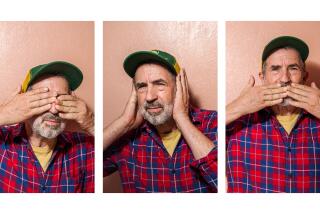‘Luck’ raises stakes on animals’ use
HBO’s”Luck” might not change how animals are used in filmed entertainment, but the odds look better after the show’s swift and surprising cancellation this week.
Set amid the hurly-burly of a racetrack, the low-rated drama starring Dustin Hoffman and Nick Nolte halted production Wednesday after the deaths of three horses used in filming raised ire among animal-rights activists. HBO said it couldn’t guarantee more accidents would not occur, but it also took pains to isolate the “Luck” case as unique given the dangers of horse racing — a point backed up by some experts.
FOR THE RECORD:
“Luck”: An earlier version of this article used a subhead that referred to the “humane society” instead of the American Humane Assn.
The incident has put a fresh spotlight on the American Humane Assn., the nonprofit group that currently monitors more than 2,000 productions that use animal performers and is partly funded by the Screen Actors Guild. The AHA, which has been criticized in the past for having overly close ties with the industry it’s charged with monitoring, has vigorously defended its handling of the horses on “Luck.”
“I believe our oversight was really excellent,” said Karen Rosa, senior vice president of the AHA’s film and television unit. “These situations are extremely unfortunate and very rare in filmmaking, so I do take issue with the criticism.”
But “Luck’s” misfortunes come at a signal moment in the animal-rights movement. Animals are being used more widely in films and TV shows, even as the public has become more sensitized to the issues surrounding their care.
That’s thanks in part to popular documentaries such as the 2009 Oscar winner”The Cove,”which depicts a harrowing process by which dolphins are captured in Japan for use at amusement parks and elsewhere, as well as books such as “Animal Liberation” by philosopher Peter Singer, widely credited with sparking the animal-rights movement. Protests have become familiar sights at circuses that use animal acts.
Industry leaders sense the shift. The Producers Guild of America recently hosted a seminar on working with animals in film that drew some 200 producers. The seminar included demonstrations from animal trainers and a presentation by an AHA official.
“We just wanted to make sure that our members were up to speed on the guidelines for the safe use of animals,’ said Charles Howard, a veteran TV producer who helped organize the event at CBS Studio Center in Studio City.
Meanwhile, the advocacy group People for the Ethical Treatment of Animals has clashed repeatedly with studios and especially the AHA. Though HBO and other companies cite their work with AHA to guarantee animal safety, activists complain that the latter group has credibility issues.
Based in Studio City, the AHA’s film and TV office has eight full-time animal safety representatives and an additional 32 on-call representatives across the country. The organization, which has been monitoring filmed entertainment for more than 70 years, often works with producers to review scripts and sends out inspectors to ensure that productions follow detailed guidelines contained in a 128-page booklet.
The guidelines outline proper procedures for handling everything from beetles and worms to lizards, horses and monkeys. Companies that comply receive the famous “No Animals Were Harmed” certification that appears in the end credits of features and TV shows.
But some animal-rights activists have raised questions over the years about the group’s ability to protect animals on sets given its ties to the entertainment industry. SAG contributes two-thirds of the $3-million annual budget for the AHA’s film and TV unit, which also is supported by grants and donations.
“From the evidence we’ve seen so far, there are very serious oversight issues,” said Kathy Guillermo, a PETA investigator who sent a letter to HBO a few days before the third horse death on “Luck.”
Guillermo said whistleblowers on the show alleged that AHA hired state-certified safety experts but many of their recommendations were ignored by the show’s producers and they were not part of the show after the first season. She also questioned the fitness of the horses to be used for filming, citing a necropsy report showing that one of the horses that died hadn’t competed since 2007 and suffered from arthritis.
“As long as animals are dying on the set something is not being done right,” Guillermo said.
Dr. Rick Arthur, equine medical director for the California Horse Racing Board, which oversees horse safety issues for the state, disputed PETA’s characterization of necropsy reports, saying there was no evidence that the horses had been medicated prior to their injuries or were unfit for use in the show.
“They went out of their way to make sure that everything was done for the safety of the horses,” he said.
In the case of horse racing, the maximum effort may still have not been enough. HBO officials learned that horse racing — whose popularity has waned in recent years — has dangers much of the public never sees, a point echoed by the sport’s enthusiasts.
“If you spend any significant time at the track, you’re going to see a horse break a leg,” said Ted McClelland, author of the memoir “Horseplayers: Life at the Track,” about his experiences at a racetrack. “Horses are oddly designed creatures. They have no muscles below the knee, and their hooves are essentially nails.
“As we saw with Barbaro and Eight Belles, even the healthiest, best-trained Thoroughbreds can break down. Landseer broke down in the 2002 Breeders Cup Mile and had to be euthanized.”
PETA has been prodding studios to end animal performances and replace them with CGI techniques, such as was done with last year’s feature hit”Rise of the Planet of the Apes.”
“With all the highly advanced technologies that are available today — including animatronics, animation, computer-generated imagery, and more — there is no reason for subjecting apes to a lifetime of misery as ‘actors,’” the organization says on its website.
But inevitably, cost considerations come into play. Fox’s”Terra Nova” of course had no choice but to create computer dinosaurs, but the elaborate special effects caused costs to balloon, helping make the show TV’s most expensive ever.
Then too, audiences have certain expectations and are quick to reject what seems fake or hokey, producers say. “Planet of the Apes” was able to use a sophisticated performance-capture process involving actor Andy Serkis, who played the chimpanzee Caesar. But the movie was science fiction and never pretended to be anything else.
“It’s hard to cheat the human eye with animatronics or CGI,” said Howard, the producer who organized the guild’s animal event. “In fantasy movies you can do that but if you have movies that are set in the real world, they expect everything to be real.”
Steven Spielberg’s World War I epic”War Horse,” which used more than 100 horses, including 14 that played the title role of Joey, completed production without an animal injury. The film used CGI effects and an animatronic horse for one battle scene, but relied mainly on the real animals.
“I knew that if we were going to tell the story, it had to be with real horses,” Spielberg said in production notes from the film. Horse trainer Bobby Lovgren worked closely with AHA representative Barbara Carr to avoid horse injuries.
“I gave her full power to pull the plug if she ever felt any of the horses were not up to the challenges or if she thought they would be injured in any way,” Spielberg said.
More to Read
The biggest entertainment stories
Get our big stories about Hollywood, film, television, music, arts, culture and more right in your inbox as soon as they publish.
You may occasionally receive promotional content from the Los Angeles Times.












